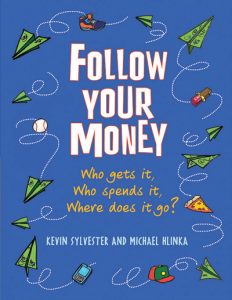 Follow Your Money
Follow Your Money
Who gets it, Who spends it, Where does it go?
by Kevin Sylvester and Michael Hlinka
Annick Press, 2013
ISBN 978-1-55451-480-9 (sc)
$14.95, 60 pp, colour illustrations, index, ages 9 – 12
annickpress.com
This book seeks to impart the essentials of financial literacy to students in grades 4 to 7. The publication is timely, since provincial education authorities across the country are actively pushing for the topic to be formally taught in both elementary and high school settings. A 2011 study of 3,000 school leavers by the B.C. Securities Commission warned that nearly 40% of high school grads had no concept of what they earned or spent in a month and 13% had recently lent out their pin number. Follow Your Money should assist middle school teachers in their attempts to remediate those worrying results. Sylvester and Hlinka, who are well known to regular CBC Radio listeners, have created a captivating series of chapters detailing why pizzas, mp3 players, cell phones and laptops normally cost what they do. The book also explains what a mortgage is and how credit card companies can still make money even if everyone pays their debts on time. All of this is accompanied by full-colour cartoon illustrations, and there is a two-page section at the end devoted to related government and NGO websites, as well as links to popular culture (is Woody from Toy Story 2 more valuable as a collectible or a beloved keepsake?)
Classroom Connections: Young people will certainly relate to many of these examples (one chapter deals with game console and online gaming costs). But a few sharp-eyed youngsters may question why sneakers that cost $10 to manufacture abroad, are sold to a retailer for three times that price here, then finally sold to a customer for more than six times the original amount. Hlinka and Sylvester never explain at all why a shoe store would require such incredible mark ups and only argue the overseas manufacturers want to ensure their “factory is as safe and modern as possible.” Clearly, Follow Your Money might also be used by teachers interested in engaging students in social justice discussions.
Review by George Sheppard.
This review is from Canadian Teacher Magazine’s Nov/Dec 2013 issue.









